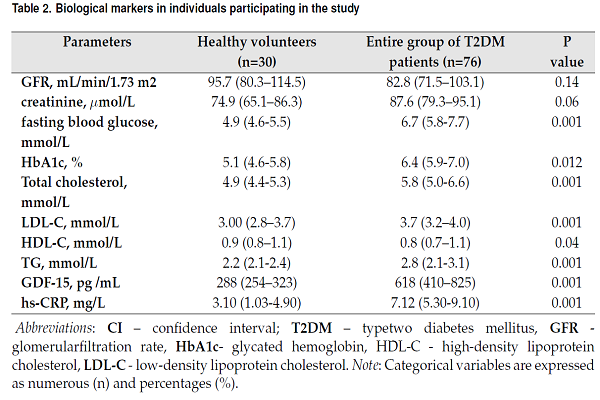Association of growth-differentiation factor-15 with the number of circulating proangiogenic endothelial progenitor cells in patients with type 2 diabetes mellitus
DOI:
https://doi.org/10.15419/bmrat.v5i7.458Keywords:
Growth-differentiation factor-15, Endothelium, Endothelial progenitor cells, Diabetes mellitusAbstract
The objective: to investigate the relationship between levels of growth differentiation factor-15 (GDF-15) and circulating number of endothelial progenitor cells (EPCs) with angiopoietin phenotypes: CD34+CD14+CD309+, and CD34+CD14+CD309+Tie2+ in patients with type 2 DM.
Methods: The study was retrospectively involved 76 patients with type 2 DM aged 38 to 55 years and 30 healthy volunteers. Data collection included demographic and anthropometric information, hemodynamic performances and biomarkers of the diseases. Flow cytometry was used to determine EPCs' populations.
Results: The levels of GDF-15 in peripheral blood of diabetics associated with age (r = 0.31, P = 0.044), high-sensitive C-reactive protein [hs-CRP] (r = 0.40, P = 0.001), smoking (r = 0.38, P = 0.001), body mass index [BMI] (r = 0.34, P = 0.001), LDL cholesterol (r = 0.28, P = 0.001), glycated hemoglobin [HbA1c] (r = -0.28, P = 0.001), number of CV risk factors (r = 0.26, P = 0.001). In univariate logistic regression analysis we found that level of GDF-15 ≥ 618 pg/mL, hs-CRP ≥7.12 mg/L, HbA1c ≥6.4%, fasting glucose ≥6.7 mmol/L, and BMI ≥27.3 kg/m2 predicted deficiency of both angiopoetic phenotypes of EPCs. In multivariate logistic regression model GDF-15 ≥618 pg/mL demonstrated the best odds ratio values for declining of EPCs in diabetics in comparison with other predictors including BMI, HbA1c and hs-CRP.
Conclusion: GDF-15 was remarkably evaluated in type 2 DM population to healthy volunteers, and it was an independent factor that contributes to mobilization and probably proliferation of endothelial precursors with high angiopoetic activity.

Downloads
Published
Issue
Section
License
Copyright The Author(s) 2017. This article is published with open access by BioMedPress. This article is distributed under the terms of the Creative Commons Attribution License (CC-BY 4.0) which permits any use, distribution, and reproduction in any medium, provided the original author(s) and the source are credited.
